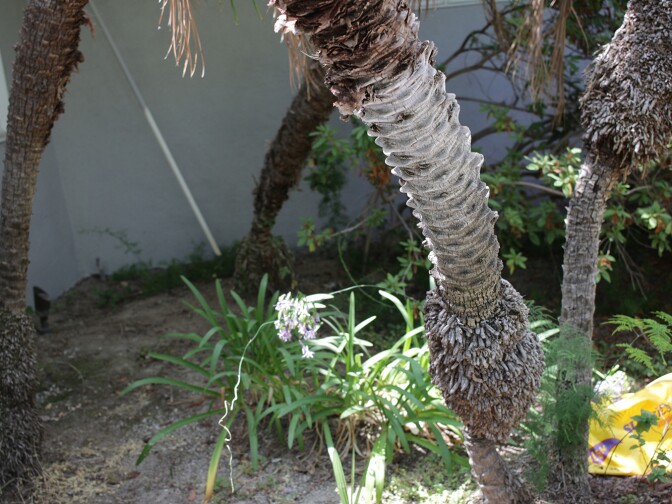With our free press under threat and federal funding for public media gone, your support matters more than ever. Help keep the LAist newsroom strong, become a monthly member or increase your support today.
Drought cutbacks challenge SoCal water officials at home
Two summers ago, Beverly Hills City Council member Nancy Krasne's household was consuming more than 1,800 gallons of water a day — far higher than the average single-family home in her city.
In preparation for California's mandatory water cutbacks, Krasne went straight to the source of her water consumption, her thirsty landscaping.
Asked recently about her lawn, she said, “What lawn? It’s gone. It has evaporated, so to speak, because I’ve shut off every sprinkler outside my house.”
Her yard has been parched for three months. Dirt sits where grass used to be, ready for drought tolerant landscaping. The steep drop in her recent water bills shows how much of the scarce resource she once used on keeping her lawn green. Her bill ending this June showed water use 67 percent lower than her bill of June 2013. She said she now tries to lead by example.
Compared to her colleagues in Beverly Hills and across Southern California, Krasne has become exceptionally frugal at the tap since 2013.
KPCC obtained comparable water use data for 40 officials in Southern California. They set policy for some of the heaviest using water districts in the region — from Calabasas to the Coachella Valley. These are the places where the State Water Resources Control Board has ordered the heftiest cutbacks of 32 or 36 percent.
So far, more than half the time, officials did not meet their own district’s target. The data end just before cutbacks began in June, but they show mandatory reductions will personally challenge some of the public officials tasked with leading the conservation charge during California’s historic drought.
RELATED: Where is California water use decreasing?
The state has ordered Beverly Hills to cut back by 32 percent. The city has translated that into a required 30 percent cut for most residential properties, a mark Krasne has flown past, now that her yard’s less lush.
Beverly Hills City Councilmember Lili Bosse's household used more than 2,000 gallons of water daily in the most recent year of billing data available — a rate of consumption more than double any of her colleagues'.
In an email, Bosse said most of that water went into her yard, a two-thirds acre plot that she has switched to drip irrigation with some drought-tolerant plants. Then there were the leaky pipes and pool problems, now fixed. Her last bill saw a drop of 28 percent from the year before. The bill before that, a spike of 20 percent. Currently, her house is meeting her city's requirement and likely won't see any penalty surcharges, come October. She called her efforts "a work in progress" and said, "I am learning, as everyone else is."
Overcoming a history of endless water in Beverly Hills
Beverly Hills has always been a refuge for the rich, an oasis where money and water flow freely, supplying beautiful, verdant spaces. The first agent to sell tracts there advertised the “inexhaustable [sic] supply of water at Beverly Hills.” The city has maintained its reputation for more than a century. Four years into the drought, mandatory cutbacks are challenging that identity.
CAPTION: The area's first real estate agent PercyClark promises endless water in Beverly Hills in this 1907 newspaper advertisement detail (Courtesy of Robert Anderson).
“We try and hold ourself out to be the garden capital of the world, but this water consumption thing is getting in the way here,” said Robert Anderson, city historian and parks commissioner. "Everybody's got to cut back."
On a recent Wednesday morning, Anderson stood admiring Will Rogers Memorial Park. The Margaret J. Anderson fountain, a water feature named after his great-grandmother, is the park's exclamation mark. Recycled water flows from the top, and pink roses hybridized especially for the city’s centennial skirt the front. Save for a couple of dirt patches in the corner, there is no drought here.
Anderson explained why the grass is still green: “There’s a couple of our parks that we have designated as jewels of the city that we need to maintain, that are major tourist attractions, that have been here since before Beverly Hills was a city.”
Like all city parks, Will Rogers is only watered twice a week. And the recreation and parks department and all other city agencies have been instructed to cut water use more than 30 percent.
That said, the bulk of reductions necessary for Beverly Hills to meet its 32 percent target will come from the city’s private homes and gardens, said Trish Rhay, assistant director of Public Works Services. She manages the city’s water program.
“Landscaping is 70 percent of our water use in Beverly Hills, so landscaping’s going to be the key for our success,” Rhay said.
How are they doing so far? In the most recent round of mandatory reporting to the State Water Resources Control Board, Beverly Hills cut back 17 percent of its water use in May 2015 — about halfway to its goal. Ninety percent of water districts in California cut back more than that for the same time frame.
Wealth and water use
Why have some been slow to change? Stephanie Pincetl, director of the California Center for Sustainable Communities at UCLA, said when it comes to what the heaviest water users have in common, "There's a very, very strong relationship between wealth and water use."
Pincetl's research suggests that, historically, Los Angeles's rich have been willing to pay more to keep from changing their habits. Living in a wealthy community on a big lot further ingrains those habits. But the threat of fines seems to be helping people realize, said Pincetl, "it's a finite resource that you can't actually buy your way out of."
“I’m hoping that through this experience with the drought, people will begin to realize you can’t actually isolate yourself from the drought," Pincetl said. "Because it’s everybody’s water and it’s finite for everybody.”
Julian Gold, mayor of Beverly Hills, wrote in an email that mandatory cutbacks in this fourth year of drought spurred his household to change habits. "Like most people in California our family started seriously conserving in April after the governor’s announcement that the state had to cut back."
Gold added, "I and every single member of the City Council take water conservation very seriously as citizens and as leaders in the community." His home's most recent bill saw a sharp drop in consumption. It was 56 percent lower than his bill from two years ago.
While some officials have taken clear steps to use less water, data show some have gone in the opposite direction. About a quarter of the time, the officials KPCC looked at saw their water use go up compared to two years ago — just as the drought went from severe to exceptional.













